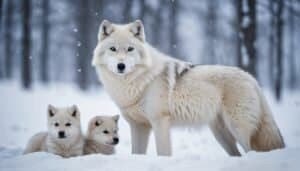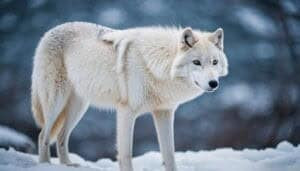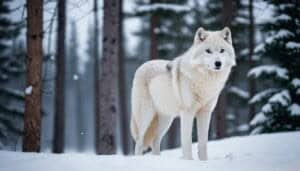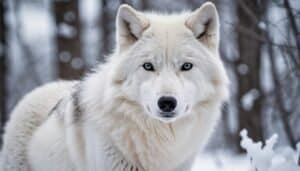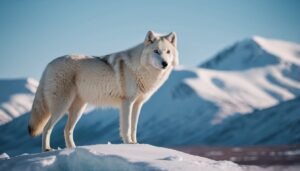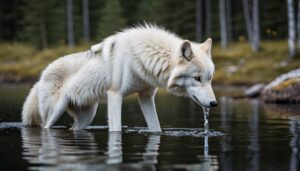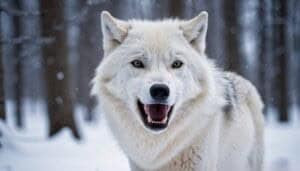Introduction
The Arctic wolf, a resilient predator of the frozen tundra, has a unique respiratory system adapted to function efficiently in extreme cold climates. This article explores the key components of the Arctic wolf’s respiratory system, including the nasal passages, trachea, lungs, and diaphragm, and how these structures work together to maintain body temperature and ensure efficient respiration
We will also examine the impact of physical activity on the Arctic wolf’s respiration and compare its respiratory system to those of other canids in different environments
Key Components of the Arctic Wolf’s Respiratory System
The Arctic wolf’s respiratory system is a marvel of natural engineering, enabling it to thrive in one of the harshest environments on Earth. This section delves into the primary components of its respiratory system: the nasal passages, trachea, lungs, and diaphragm. Understanding these components and their specific adaptations is key to appreciating how the Arctic wolf breathes efficiently in cold climates
Nasal Passages Function in Cold Climates
The nasal passages of the Arctic wolf are uniquely adapted to cold climates. These passages are lined with a dense network of blood vessels and mucous membranes that serve multiple functions. As the wolf inhales, cold air passes through the nasal passages, where it is warmed by the heat from the blood vessels. This warming process ensures that the air reaching the lungs is at a suitable temperature, preventing potential damage from cold air
Moreover, the mucous membranes help to humidify the air, adding moisture that protects the delicate tissues of the respiratory tract. The nasal passages also filter out dust and other particulates, ensuring that the air entering the lungs is clean. This filtration is critical in the Arctic environment, where the dry and cold air can carry fine ice particles and other debris
Role of the Trachea in Respiration
The trachea, or windpipe, is another vital component of the Arctic wolf’s respiratory system. It connects the nasal passages and larynx to the lungs, acting as the main conduit for air flow. The trachea is reinforced with cartilaginous rings that keep it open, allowing for uninterrupted air passage
In cold climates, the trachea’s lining plays a crucial role in maintaining respiratory efficiency. The lining contains cilia and mucous glands that trap and expel foreign particles and pathogens, further ensuring that the air reaching the lungs is clean. The trachea’s robust structure and its protective linings make it well-suited to the demands of the Arctic environment
Adaptations of the Lungs
The lungs of the Arctic wolf are highly efficient at extracting oxygen from the air and expelling carbon dioxide. They are adapted to function optimally in cold climates through several mechanisms. First, the lung tissues are dense and richly supplied with blood vessels, which enhance the exchange of gases even in lower temperatures. This vascular network ensures that oxygen is efficiently absorbed and transported throughout the body
Additionally, the Arctic wolf’s lungs have a large surface area due to numerous alveoli, the tiny air sacs where gas exchange occurs. This extensive surface area maximizes the amount of oxygen that can be absorbed in each breath
Furthermore, the flexibility and strength of the lung tissues help maintain lung function even in the frigid Arctic air, which can be dry and harsh
Function of the Diaphragm
The diaphragm, a large muscle located below the lungs, plays a crucial role in the Arctic wolf’s breathing process. During inhalation, the diaphragm contracts and moves downward, creating a vacuum that draws air into the lungs. Upon exhalation, the diaphragm relaxes and moves upward, pushing air out of the lungs
In cold climates, the diaphragm’s efficiency is essential for maintaining adequate oxygen intake. The muscle’s strength and endurance are adapted to ensure that the Arctic wolf can breathe deeply and steadily, even during physical exertion or in severe weather conditions. This muscular efficiency is critical for sustaining the wolf’s energy levels and overall health in its demanding environment
Maintaining Body Temperature Through the Respiratory System
Maintaining body temperature is a critical function of the Arctic wolf’s respiratory system, particularly in the extreme cold of its natural habitat. This section explores how the Arctic wolf’s respiratory system helps regulate body temperature, focusing on the mechanisms that prevent heat loss and the changes in respiratory rate in cold weather
Preventing Heat Loss
One of the key adaptations of the Arctic wolf’s respiratory system is its ability to minimize heat loss. The nasal passages, as previously mentioned, play a significant role in this process
As the wolf inhales cold air, the warm blood in the nasal passages heats it, ensuring that the air entering the lungs does not lower the body’s core temperature. This warming process is crucial for conserving heat, which is vital for survival in the Arctic climate
Additionally, the Arctic wolf exhales warm, moist air. As this air passes back through the nasal passages, some of the heat and moisture are recaptured by the mucous membranes and blood vessels. This heat recovery process reduces the amount of heat lost to the environment with each breath, further helping to maintain the wolf’s body temperature
The trachea and lungs also contribute to heat conservation. The trachea’s structure helps retain warmth, and the dense vascular network in the lungs ensures that the air is efficiently warmed and humidified before it reaches deeper into the respiratory system
Changes in Respiratory Rate in Cold Weather
The Arctic wolf’s respiratory rate can vary significantly depending on the temperature and the wolf’s level of activity. In cold weather, the wolf’s respiratory system adapts to maintain body temperature and energy efficiency
When the wolf is at rest, its respiratory rate is slower, which helps conserve energy and minimize heat loss. By breathing more slowly, the wolf reduces the amount of cold air entering its body, thereby reducing the cooling effect on its core temperature. This slower rate also allows more time for the nasal passages and trachea to warm and humidify the air
During physical activity, the Arctic wolf’s respiratory rate increases to meet the higher oxygen demands of its muscles. Despite the increased rate, the wolf’s respiratory system remains efficient at conserving heat. The diaphragm and intercostal muscles (muscles between the ribs) work harder to ensure deep, steady breaths, allowing for optimal gas exchange without excessive heat loss
Moreover, the increased blood flow during physical exertion enhances the warming and humidifying processes in the nasal passages and lungs. This adaptation ensures that even during intense activity, the Arctic wolf can maintain its body temperature and respiratory efficiency
Impact of Physical Activity on Respiration
Physical activity significantly affects the Arctic wolf’s respiratory system, requiring it to adapt quickly to meet the increased oxygen demands and maintain body temperature in cold climates. This section examines how the Arctic wolf’s respiration changes with physical exertion and the adaptations that support these changes
During periods of physical activity, such as hunting or traveling across the tundra, the Arctic wolf’s respiratory rate increases to supply more oxygen to its muscles. This increased demand for oxygen is met through deeper and more frequent breaths. The diaphragm and intercostal muscles play a crucial role in this process, working harder to facilitate greater air intake and expulsion
Increased Respiratory Rate
As the Arctic wolf engages in physical activity, its respiratory rate can increase significantly. This increase is essential to provide the necessary oxygen to the muscles and remove carbon dioxide produced during exertion. The respiratory system’s efficiency in cold climates ensures that despite the increased breathing rate, the air remains warm and humidified, preventing damage to the respiratory tissues
The nasal passages, with their extensive vascular network, continue to warm the incoming air, while the trachea and lungs ensure that the air is adequately humidified. These adaptations prevent the respiratory system from being overwhelmed by the cold air, even during intense activity
Enhanced Oxygen Delivery
The Arctic wolf’s lungs are highly efficient at gas exchange, which is critical during physical exertion. The dense network of blood vessels in the lungs ensures that oxygen is quickly absorbed into the bloodstream and transported to the muscles. The large surface area provided by the alveoli maximizes the amount of oxygen that can be absorbed in each breath
During physical activity, the cardiovascular system works in tandem with the respiratory system to enhance oxygen delivery. Increased heart rate and blood flow ensure that oxygenated blood reaches the muscles rapidly, supporting sustained activity and endurance
Thermoregulation and Respiration
Thermoregulation is a critical function of the Arctic wolf’s respiratory system during physical activity. The increased breathing rate during exertion generates more heat, which helps maintain body temperature in cold environments. However, this also poses a risk of overheating if not properly regulated
The Arctic wolf’s respiratory system manages this by balancing the need for oxygen with the need to conserve and dissipate heat. The efficient heat exchange mechanisms in the nasal passages and lungs ensure that the wolf can maintain a stable body temperature without excessive heat loss or gain. This balance is crucial for the wolf’s survival, allowing it to remain active and effective as a predator in the harsh Arctic climate
Comparison to Other Canids’ Respiratory Systems
The Arctic wolf’s respiratory system showcases several unique adaptations that allow it to thrive in extreme cold climates. Comparing its respiratory system to those of other canids, such as gray wolves, coyotes, and domestic dogs, highlights these specialized features and provides a broader understanding of how different environments shape respiratory adaptations
Arctic Wolf vs. Gray Wolf
While both the Arctic wolf and the gray wolf share a common ancestor and have similar overall respiratory structures, the Arctic wolf has specific adaptations for colder climates. Gray wolves typically inhabit temperate and subarctic regions, where the air is warmer and less dry than in the Arctic. Consequently, gray wolves do not have as extensive a network of blood vessels in their nasal passages for warming the air
The Arctic wolf’s nasal passages are more efficient at heat exchange, which is crucial for survival in temperatures that can plummet well below freezing. This efficiency helps the Arctic wolf minimize heat loss, a feature that is less critical for gray wolves in milder climates
Arctic Wolf vs. Coyote
Coyotes are highly adaptable and can be found in a variety of environments, from deserts to urban areas. Their respiratory systems are less specialized for extreme cold compared to the Arctic wolf. In warmer climates, the emphasis is more on cooling the body, and the respiratory system plays a role in thermoregulation by allowing heat dissipation
In contrast, the Arctic wolf’s respiratory system is designed to conserve heat. The extensive mucous membranes and blood vessels in the nasal passages of the Arctic wolf are less pronounced in coyotes, reflecting the different environmental pressures each species faces
Arctic Wolf vs. Domestic Dog
Domestic dogs, especially those bred for warmer climates, have respiratory systems that differ significantly from those of the Arctic wolf. Dogs in warm environments often rely on panting as a primary means of thermoregulation, using their respiratory system to dissipate heat quickly
In Arctic wolves, panting is less common because it would lead to excessive heat loss. Instead, their respiratory system focuses on conserving heat through efficient warming and humidifying of inhaled air
Breeds like the Siberian Husky, which are adapted to colder climates, show some similar features to Arctic wolves, such as thick fur and a greater ability to conserve heat, but even these breeds do not match the Arctic wolf’s extreme cold adaptations
Adaptations Across Canids
All canids share a fundamental respiratory anatomy that includes the nasal passages, trachea, lungs, and diaphragm. However, the extent and nature of their adaptations can vary significantly based on their environment. Canids in colder climates, like the Arctic wolf, have evolved to conserve heat and moisture, while those in warmer climates have developed mechanisms to efficiently dissipate heat
Understanding these differences highlights the remarkable adaptability of the canid family and the specific evolutionary paths taken by species like the Arctic wolf to survive in some of the planet’s harshest conditions
Conclusion
The Arctic wolf’s respiratory system is a remarkable example of evolutionary adaptation to one of the harshest environments on Earth. This system comprises several key components—nasal passages, trachea, lungs, and diaphragm—that work together to ensure efficient respiration and maintain body temperature in extreme cold climates
The nasal passages play a crucial role in warming and humidifying the cold air before it reaches the lungs, minimizing heat loss and protecting delicate respiratory tissues. The trachea, reinforced with cartilaginous rings, ensures a clear and protected airway, while the lungs, with their extensive vascular network and large surface area, maximize gas exchange efficiency. The diaphragm’s strength and endurance facilitate deep and steady breathing, crucial for oxygen intake and energy conservation
Maintaining body temperature is a vital function of the Arctic wolf’s respiratory system. Mechanisms like heat exchange in the nasal passages and regulated respiratory rates during rest and physical activity help conserve heat. Physical activity increases the respiratory rate to meet higher oxygen demands, with adaptations ensuring continued heat conservation and efficient oxygen delivery
Comparing the Arctic wolf’s respiratory system to those of other canids, such as gray wolves, coyotes, and domestic dogs, highlights the specialized features developed for extreme cold. While all canids share basic respiratory anatomy, the Arctic wolf’s system is uniquely adapted for heat conservation, reflecting the specific environmental pressures of its habitat
These adaptations underscore the incredible resilience and adaptability of the Arctic wolf, enabling it to thrive in the frozen tundra. Understanding these physiological mechanisms not only provides insight into the Arctic wolf’s survival strategies but also enriches our appreciation of the diversity and ingenuity of life in extreme environments


